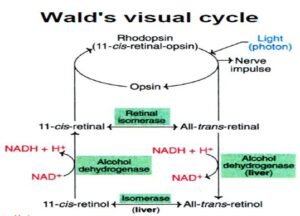What are Vitamins?
The vitamins are an essential, non-caloric, organic nutrient essential in minute amounts in the diet and were discovered at the beginning of the 20th century.
Vitamins may be considered or regarded as organic compounds required in the diet in small amounts to perform specific biological functions for the normal maintenance of optimum growth and health of the organism.
Doctors like to prescribe vitamins and millions of people take them but it requires a good deal of biochemical sophistication to understand why they are needed and how the body uses them.
The only disease a vitamin can cure is the one caused by a deficiency or scarcity of that vitamin.
Vitamins A:
There are three forms of vitamin A, which is important for human health, they are;
- Retinal
- Retinoic acid
- Retinol (key player; which can be converted to other forms).
- β-carotene (a carotenoid or pigment): It present in yellow/orange foods is a potent provitamin A.
Dietary Sources:
- Animal Sources: Liver, Kidney, Egg yolk, milk, and milk products, fish liver oils.
- Plant Sources: Yellow and dark green vegetables; mango, carrots, spinach, papaya.
Dietary Requirements:
- Adults: 5000IU(Men), 4000IU(Women)
- Children: 1500 – 5000 IU
- Pregnancy: 6000 IU

Wald’s visual cycle (@Vitamins)
Rhodopsin (molecular weight is 35,000) is a conjugated protein present in rods. Rhodopsin contains 11-cis retinal and the protein opsin. The aldehyde group of retinal is linked to the ε-amino group of lysine (of opsin).
The primary event in the visual cycle, on exposure to light, is the isomerization of 11-cis-retinal to all-trans-retinal. And that leads to a conformational change in opsin which is responsible for the generation of a nerve impulse.
The all-trans-retinal is instantly isomerized by retinal isomerase( of retinal epithelium) to 11 -cis- retinal. This combines with opsin to restore rhodopsin and complete the visual cycle in humans.
However, the conversion of all-trans-retinal to 11-Cis retinal is incomplete. Therefore, most of the all-trans-retinal element is transported to the liver and converted to all-trans-retinol by alcohol dehydrogenase.
The all-trans-retinol goes through isomerization to 11–cis retinol which is then oxidized to 11-cis retinal to participate in the Visual cycle.
Vitamins A deficiency
It is due to deficiency symptoms that are not instant since hepatic stores can meet the body’s requirement for some time. The disease is related to skin, eye & growth.
- Night blindness(Nyctalopia): difficulty to see in dim light.
- Xeropthalmia: Dryness in cornea & conjunctiva.
- Keratinization of epithelial cells in certain areas of conjunctiva white triangular plaques known as Bitot’s spot is seen.
If xeropthalmia persists for long →corneal ulceration and degeneration occur → destruction of the cornea (keratomalacia) → causes total blindness.
- Growth: Growth retardation- ↓skeletal growth.
- Reproduction: Degeneration of epithelial germinal cells-↓ resulting in sterility, termination of pregnancy.
- Skin and epithelial cells: Skin becomes rough and dry-Pharyoderma.
- Keratinization of epithelial cells of GIT, UT, RT.
Eyesight
A more serious deficiency or scarcity of vitamin A occurs when the protein keratin accumulates and clouds the eye’s outer vitamin A-dependent part, the cornea.
Keratinization of the cornea can lead to xerosis (i.e. drying) & then progress to thickening & permanent blindness, xerophthalmia.
500,000 of the world’s vitamin A-deprived (needy) children become blind each year due to xerophthalmia.
Hypervitaminosis A
Excess consumption leads to toxicity. Hypervitaminosis A occurs after the liver storage of retinol and its esters exceed 10,000 IU.
- Acute toxicity: abdominal pain, nausea, vomiting, severe headaches, dizziness, sluggishness.
- Chronic toxicity: bone and joint pain, hair loss, dryness, fissure of lips, hepatomegaly, weight loss.
[embeddoc url=”https://notesmed.com/wp-content/uploads/2020/08/vitamins_1.pdf” download=”all” cache=”off”]